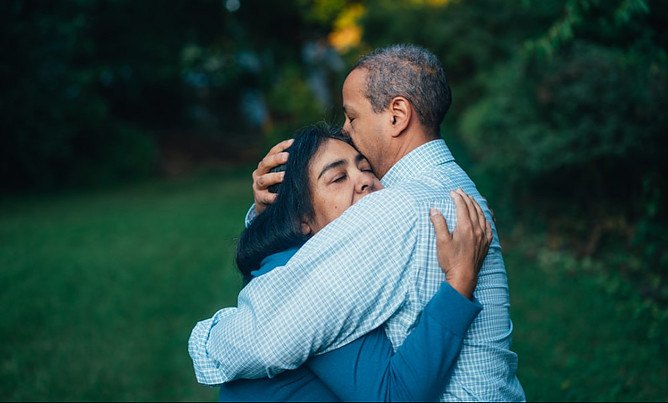There are two different pain versions, which are emotional pain and physical pain. Each person encounters the pain at a varied level of intensity; nevertheless, they may appear with the same symptoms. A wide range of psychological factors influences pain, which is a subjective experience. But, most of our readers ask, Can Emotional Pain Cause Physical Pain?
An excellent question, and that’s what exactly we will be addressing in this article. But, before that, let’s define what emotional and physical pain really is.
What is Emotional Pain?
Emotional pain is the suffering of a psychological and non-physical origin.
The other terms for emotional pain are mental pain, psychic pain, psychological pain, emptiness etc.
Emotional pain is interpreted as a response to adapt to repetitive traumatic experiences in childhood, such as the loss of a parent, parental mental illness, and witnessed violence, emotional, physical and sexual abuse.
Emotional pain is intense in women who suffer from borderline personality disorders and exposure to childhood abuse. Suicide risk is much higher when the emotional pain reaches intolerable.
Types of Emotional Pain
Here are the common types of emotional pains.
1. Guilt
Guilt is a feeling commonly arise from and within us.
It is a repetitive thought and a feeling within us telling us that you have caused or done something ‘terrible’ to someone, if not to your own self. Usually, in this case, you may also think that due to your actions in the past now you or someone in your life is undergoing a life challenge or had to face hardship.
Remember, guilt can affect us all in many different ways. Feeling guilty will have long-term emotional problems.
2. Rejection
The feeling of ‘rejection’ is another common emotional challenges.
Rejection may come in different ‘faces’ and kinds. It may come from a personal relationship (from a partner, family member or a friend) or in a professional environment (from a co-worker or boss).

Although social awareness of the rejection is ‘poor’, if ignored, its effects can be detrimental to anyone making them question his or her self-worth.
Ultimately our self-worth is what keeps us all ‘going’ and once someone loses their ‘self-worth’ that could result in suicide (sometimes).
3. Grief
Grief is the regular reaction to any loss. It is created of emotions. Also, there are various levels of grief, such as:
- acceptance,
- bargaining,
- denial,
- depression, and
- · anger.
4. Loneliness
Feeling lonely or the feeling of loneliness (with or without being alone) can cause a considerable amount of emotional drain.
Loneliness is painful and confuses people into thinking that he or she is a loser, an outcast.
Loneliness can overcome by meeting people and finding people interested in common grounds.
5. Brooding
Brooding is a continuous comparison of one’s current situation to others with or without intention to do so.
Brooding slowdowns you and prevents emotional healing as it can take you away from ‘mindfulness’.
Brooding reignites your emotional distress and influences physical and mental health.
6. Failure
Failure is associated with different forms and levels of sadness, emotions, anxiety, shame, embarrassment and anger.
Tip: Here are the best anxiety–relieving bracelets.
7. Shame
Shame leads to avoidance of contact and to physical, psychological and social withdrawal. If not identified and overcome early, it could lead to irritability and antisocial aggression.
Now, knowing a lot about emotional pain, let’s turn into physical pain.
What is Physical Pain? Types of Physical Pain
Physical pain is usually associated with physical injuries to our body. It can also be associated with a disease or an injury. For example, nerve pain as a result of diabetes.
Based on the location of the pain, physical pain can be divided into the following
- Headaches, migraines and head pains
- Neck pains
- Shoulder pains
- Hand pains
- Chest pains
- Abdominal pains
- Back pains
- Hip and groin pains, and
- Leg pains
Based on the length of ‘pain’, the main types of physical pain include
- Acute pain, which initiates promptly and takes place in a short-term, and
- Chronic pain that stays for a long span of time.
The break-through pain refers to the pains that usually occurs in between scheduled, regular painkillers.
Tip: Cefaly is the latest technology to help people experiencing migraine headaches.
Emotional Stress and Physical Pains
Chronic pain, which is a long-lasting version of pain, may occur by stress and emotional issues.
Tip: This article comes with tips on how to help a stressed partner.
As discussed earlier, stress response may lead to many negative physical and psychological outcomes.
For example, post-traumatic stress disorder causes higher levels of disability from pain.
Stress can cause health problems like high blood pressure, heart disease, obesity and diabetes.
Anxiety causes muscle tension, arm pain, stomachache, jitteriness, chest pressure, fatigued.
Emotional pain, if not identified early and managed well, may lead to a longer-lasting, and more severe forms than physical pain.

Tip: Here are the best supplements for stress and anxiety.
Some even argue that emotional pain and physical pain are the same. Emotional pain can cause physical pain and vice versa, where physical pain cause emotional pain are both prevalent.
What are Common Pains Caused By Emotions?
Emotional pain might be a case of ‘addiction’ to some individuals. It is overwhelmed with a sort of feelings such as:
- fear,
- guilt,
- shame,
- depression or
- sadness.
Tip: Amino Acids can help you manage anxiety, depression and low mood better.
These feelings become so constant and regular that can make you feel as if it is a component of you, to the extent that someone may not expect their life without these feelings.

When someone is exposed continually to emotional pain, there would be some changes in their brain, which in return shall produce a dependency mechanism on that set of feelings. Since this emotional pain may be debilitating and significant, it keeps on progressing for an extra span of time, which may lead to some effects to your physical health as a result and this is a direct consequence of a physical pain out of emotional pains.
Difference Between Emotional Pains and Physical Pain
- Usually, memories trigger most of our emotional pain but not necessarily physical pain. That’s why I noted earlier, having an ‘abusive childhood’ have a role in how one would react to emotional and physical pains.

- Most people use physical pain as a response and distraction to/from emotional pain.
- Physical pain is quite ‘transparent’, can easily garner more empathy from others than emotional pain. In comparison, a person may go through severe emotional pain by showing no clue about it to their loved ones.
- Physical pain is usually easily explainable; however, emotional pain may echo in ways very different from physical pain.
- Emotional pain damages our self-esteem and long-term mental health. In contrast, physical pain has to be extreme to affect our personalities or damage our mental health.
- In a healthy individual, physically painful experiences are always less compared to the emotionally painful experiences.
- Believe it or not, physical pain has less detrimental effects than emotional pain.
How to Prevent Emotions Manifest into Physical Pain?
If you struggle with emotions for a while, the following tips will help you to overcome them before they become part of your day to day life appearing like ‘physical pain’.
1. Talk to your doctor or therapist
It’s important to talk to not only with your doctor but also loved ones about how you feel. Seek help.
2. Triggers
Identify triggers, which could drain you emotionally and result in a bad day.
If you don’t know what are they as yet, work with your doctor or psychologist to identify specific triggers that bring you emotional pain.
3. Self-treatment
Remember, self-treatment is not useful always. When it comes to nerves and emotional, the chances of things to go wrong is high with self-treatment.
Again, the advice here is to work with your therapist to identify the best treatment strategies tailored to you.
4. Global distress
If you are sad about life overall, again therapist is in the best position to better understand you and advice.
5. Emotional and behavioral avoidance
If you avoid certain emotions and actions as a precaution to run away from the core of your pain, then be open about it. Sometimes, avoidance is not the only option in moving on and strengthen your emotional nerves.
Your doctor can understand and advise you how to approach such challenges if you avoid pain triggers that precipitate to your emotional pain.
6. Self-compassion
Be compassionate about you and your challenges. Your doctor can guide the treatment to facilitate you have a good self-compassion.
7. Grief and letting go
After all, easier said than the practice, but you should learn how to let go, as that can be the ultimate solution for some problems.

Your psychologist can also help you to let go of any unresolved emotions.
How Physical Pain Becomes Emotional Pains?
The peripheral pain receptors, defined as nociceptors, usually appear on the skin surface, which is activated during the application of a stimulus. This activation releases inflammatory mediators like, hormones, for example, serotonin, from damaged tissue prostaglandins
and bradykinin.
The stimulus is then converted into electrical signals and passes down sensory neurons, after which the signals are transmitted through the nerve cells to the CNS or central nervous system.
Tip: TENS and EMS can help with managing physical pains.
The dorsal root ganglion let the signals travel to the dorsal horn of the spinal cord. This dorsal root is a combination of the cell bodies of sensory neurons. Therefore, in order to feel with pain, the signals from the spinal cord travel along with the spin thalamic tract that is ascending pain pathway then reach different areas of the brain such as the thalamus and cortex.
Additional complicated pathways and systems are then incorporated after the signal arrives in these areas, in order to identify how pain is perceived.
Now we have covered both emotional pain and physical pain, but have you heard about psychogenic pain?
What is Psychogenic Pain?
Psychogenic pain is a physical pain, which happens due to behavioral, prolonged mental and emotional factors.
Headache, back pain and stomach pain are common types of psychogenic pains.
Psychogenic pain is a disorder linked to psychological factors. In this case, some versions of emotional or mental issues can lead to, prolong or increase pain.

Tip: Essential oils can help you with lightheadedness.
A patient with psychogenic pain disorder might feel pain, irrelevant to the main causes of pain.
Psychogenic pain identifies both long and short-term levels of pain, which may occur because of some psychological disorders, as well.
Can Emotional Pain Manifest into Psychogenic Pain?
Emotional pain disorders, when being chronic, has different symptoms. These pains might be severe to mild, and sharp or dull.
In common, psychogenic pain leads to general symptoms such as:
1. Despite taking medication, constant pain discomfort continues.
2. More pain despite any underlying medical situation.
3. Difficulty in mentioning the depth, quality and location of the pain.
4. Larger parts of the body encompass non-localized pains.
In case some of the previously mentioned symptoms appear in the absence of a chronic disorder with a physical cause, then the individual probably is suffering from a psychogenic pain.
In some scenarios of psychogenic pain, happen as a reaction to the last injury, rarely, the pain stems usually through a mental ailment.
In many situations, this pain leads to an existing pain because of some physical stimulus to encounter more intense pain.
Since the brain is the center for location of discomfort and deciphering levels, patients with an underlying emotional pain are at high risk for encountering psychogenic pain.
Psychogenic pain is also of two types:
1. Acute psychogenic pain
2. Chronic psychogenic pain
Causes of Psychogenic Pain
Psychogenic pain happens due to psychological factors such as:
1. Anxiety disorder
2. Obsessive-compulsive behavior
3. Depression
4. Bipolar disorder
Psychogenic Pain Treatment
The treatment of psychogenic pain is thought of only after the other symptoms of pain are ruled out.
A patient with a disorder of psychogenic pain will be complaining of pain that may not be a match to his or her regular symptoms.
Your mental health specialists and medical doctors will work together to find out a helpful outcome to this disorder, for improving your condition and quality of happiness.

Tip: Knee Pillows can help most of the chronic body aches go away, even the neck pains.
Prevention of Psychogenic Pain – How Doctors Can Help?
Pain disorder can be eliminated during the early stages, such as, in the early stages of recurring pain or at the onset of pain.
In the late stages of pain, it requires an extensive team of doctors to manipulate effective methods for treatment before developing other distressing consequences.
Many individuals in pain firstly communicate with their physician to assign a proper pain clinic or a mental health professional to look after their case closely. Some of the physicians may reassure the patient that the mental health professional for psychological diagnosis is not going to stigmatize, or does not in any method, decrease the medical condition or the pain experience. However, this does not mean that the primary care physician or your GP thinks that the pain is imaginary.
There are some objectives of pain management, which has to be acquired in order to successfully treat pain disorders, as follows:
1. The pain nearly usually benefits after diagnosis; however, the best control might be hard to attain, especially initially.
2. Optimizing function and comfort in the face of inevitable deterioration, which is the overarching objective of pain management.
3. Engaging the patient in managing their pain.
Tip: Did you know that Art Therapy can help you too.
Summary
The efficacy of feeling with pains is responsible for the variability in response to pain. The brain is responsible for modulating the pain. Both physical pain and emotional pain share the same neural circuitry.
Pain disorder can be eliminated at an early time of recurring pain. However, if pain transformed to be chronic, it is critically important to search for help or learn about and incorporate other strategies to treat the distress before the development of hopelessness, chronic fatigue or depression.









0 Comments